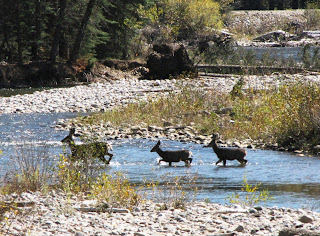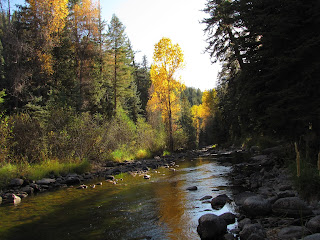There is something mystical and secret about sitting still by a mountain river, watching or hearing it hop from one polished rock to another. There is something of the old ages, a story or many told only to few of those who really listen, in an effort to become one with the big world. I crave this experience. I crave the sounds, the crisp air, the unbearable, headaching silence in the night, the dance of the squirrels on the branches, the chasing of the robins in the air. I crave the mountains, the stream, and a cozy cabin just about every day. But we allow ourselves the luxury to escape into this otherworld only about once a year. Not nearly enough, if you asked me, but the rarity makes these experiences that much more special.
This year's cabin was on the Florida river, about 20 minutes from downtown Durango, Colorado. Before the trip, I told my husband I have never taken a trip to Colorado that I didn't love. And this trip was not going to break that pattern.
This is a state cut out of a National Geographic issue, or an Ansel Adam's photography book, drowned in peace. If you have ever made a mental picture of Colorado after watching Western movies, reading Winnetou or watching The Wilderness Family series – then Colorado is all that times infinite. In my mind, the picture perfect Colorado starts with a yellow pasture where horses roam. They are framed by aspen trees, melted gold in the fall, over which the pine trees arise, and ultimately, the stony peaks of The Rockies. I could not have wished for anything more in the cabin getaway this year, than this.
Timeless Colorado ...
Our cabin was a duplex, but the neighbors we had for one night were ever so quiet and polite, we hardly noticed them. The sounds of the stream, the gentle wind through the crispy yellow aspen leaves is all I remember. There is something enduring, close and comfortable about log cabins. The raw-ness of the materials, the shortness of the walls, the hard stability of the dirt floors. It's like a cocoon, safe and sturdy, keeping you away from the big bad cold outside. Keeping you away from the beasts. There is restorement and rejuvenation after a solid night sleep surrounded by wood and woods. This is what keeps us going for another year. This, and the dream of another cabin to discover the year next.
I wish you all to find your cabin and your mountain. There is nothing that says “home” more loudly, and there is nothing where you're more “you-er than you”, than your secret, peaceful, getaway place.
Colorado back country ...
During our explorations around our cabin, we found several county roads that are hardly paved, that took us for miles and miles around horse farms and more log cabins. The hidden country of Colorado was alive and beautifully quiet on these hidden pathways. The silence and solitude reigned supreme, in a perfectly beautiful day of autumn. The air was soft and yellow, the bugs were lazy, trying to find their end-of-the-summer tired wings for one last flight, the deer and elk were everywhere, horses, too, but the people were off that day, tucked away in hiding. Even the windmills were stopped.
Quiet windmill on a Colorado farm
Mountains have always given me a sense of eternal timelessness. I go to the mountains I grew up in over the years and nothing ever seems changed, except for the new wrinkles on people's faces. The world, the land is still the same – beautiful and untouched, as always. You get this feeling anywhere else in the world, where there are mountains.
We stumbled upon Vallecito Lake, about 20 miles away from our cabin. It's tucked away, like a precious secret, circled by mountain ranges, and it's crystal clear and cold as a mountain lake should be. It reminded me of a diminutive Lake Tahoe. There is nothing I love more than getting lost on roads I don't know, and taking in the nature, and nothing besides. Driving around on Colorado back roads is like that. You're one with the trees, the deer and the brass leaves and you feel bad for intruding and disturbing the eternal peace.
Vallecito Lake under the aspen trees
Detail on one of the many carvings (in dead, standing trees) around Vallecito Lake
On the side of the road, crossing the stream, on one of our drives. Right before we got to Vallecito Lake
Durango is your typical Western mountain town. Old buildings, of wood and brick, with their wooden entryways, with no alleys between them, still flank the sidewalks. You walk under wooden overhangs, with Western cowboy-book resonance in their names like Lone Spur Cafe, Pine Needle Mountaineering or Duranglers, or El Rancho Tavern. To not disturb the quiet of the setting it's in, Durango is also a quiet, sleepy kind of town, too. Nothing much rushes here. Coffee shops have lines that never move and food takes a while to come to your table.
Downtown Durango - this vision of a train teleported me right back to Dr. Quinn, Medicine Woman's time
It's a bohemian kind of town, where they can still keep in business two music stores within 10 feet from one another, still selling vinyl and cd's, and a locally owned, hopping book shop, with new books, not just antiques. The Mac store is called The Mac Ranch.
It's a “feel good” kinda town, too: puppies are not only welcome everywhere, but every store owner has treats to give them, too. There are two establishments (The Himalayan Kitchen and the gift store, Dreams of Tibet) that sell originally Tibetan, Nepalese and Himalayan food, clothes and décor to support the Tibetan people. It's like a World Market, but … not a chain.
And don't let me forget about the local grub and drinks! I had heard that Durango is famous for its breweries, and it did not disappoint in the selection of beers, everywhere. The Main Avenue Madness breakfast at The Carver Brewing Company tastes exactly like what The South West should taste like: it's a mess of all things you can find in your kitchen – which is the only way to go for real food, really: perfectly roasted potatoes, black beans, peppers, mushrooms, onions, verde sauce. Like everywhere else in The West, we looked for hours for trout. We finally found it at The Mahogany Grill in the historic Strater Hotel, and it was fishy perfection.
The trout at the Strater Hotel
The clocks spin by a totally different speed here. No rush and no high blood pressure. Just a smooth feeling of passing the days, from dawn till sunset. Just like the river which does not know what it rushes itself onto, people and much of the world don't either. They live, they die, and pastures are still filled with horses, deer and yellow, brassy leaves, every fall, unmistakably and unplanned.
You'll find that in all mountain towns people speak slower, walk even more so, and they smile more. Here, they have decoded the secret of life and there is no more rushing towards any other goal. A cabin on a river is the only reality. The Rockies. A lake. A hideaway long weekend. The love of puppies, cozy sweaters. A fireplace at the end of the day. A journal. The love of life. What more is there to seek?!
The Florida River, behind our cabin, in the sunset. Click on the picture for more shots of Durango and around.














